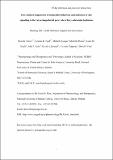| dc.contributor.author | Butler, Ryan K. | |
| dc.contributor.author | Ford, Gemma K. | |
| dc.contributor.author | Hogan, Michelle | |
| dc.contributor.author | Roche, Michelle | |
| dc.contributor.author | Doyle, Karen M. | |
| dc.contributor.author | Kelly, John P. | |
| dc.contributor.author | Finn, David P. | |
| dc.date.accessioned | 2012-01-20T10:54:16Z | |
| dc.date.available | 2012-11-21T15:57:07Z | |
| dc.date.issued | 2011-09-17 | |
| dc.identifier.citation | Butler RK, Ford GK, Hogan M, Roche M, Doyle KM, Kelly JP, Kendall DA, Chapman V, Finn DP (2011). Fear-induced suppression of nociceptive behaviour and activation of signal transduction molecules in the rat periaqueductal grey: role of fatty acid amide hydrolase. | en_US |
| dc.identifier.uri | http://hdl.handle.net/10379/2497 | |
| dc.description.abstract | The endocannabinoid system regulates nociception and aversion and mediates fear-conditioned analgesia (FCA). We investigated the effects of the fatty acid amide hydrolase (FAAH) inhibitor URB597, which inhibits the catabolism of the endocannabinoid anandamide and related N-acylethanolamines, on expression of FCA and fear and pain related behaviour per se in rats. We also examined associated alterations in the expression of the signal transduction molecule phospho-Akt in the periaqueductal grey (PAG) by immunoblotting. FCA was modelled by assessing formalin-evoked nociceptive behaviour in an arena previously paired with footshock. URB597 (0.3 mg/kg, i.p.) enhanced FCA and increased fear-related behaviour in formalin-treated rats. Conditioned fear per se in non-formalin-treated rats was associated with increased expression of phospho-Akt in the PAG. URB597 reduced the expression of fear-related behaviour in the early part of the trial, an effect that was accompanied by attenuation of the fear-induced increase in phospho-Akt expression in the PAG. Intra-plantar injection of formalin also reduced the fear-induced increase in phospho-Akt expression. These data provide evidence for a role of FAAH in FCA, fear responding in the presence or absence of nociceptive tone, and fear-evoked increases in PAG phospho-Akt expression. In addition, the results suggest that fear-evoked activation of Akt signalling in the PAG is abolished in the presence of nociceptive tone. | en_US |
| dc.format | application/pdf | en_US |
| dc.language.iso | en | en_US |
| dc.publisher | Sage | en_US |
| dc.rights | Attribution-NonCommercial-NoDerivs 3.0 Ireland | |
| dc.rights.uri | https://creativecommons.org/licenses/by-nc-nd/3.0/ie/ | |
| dc.subject | Akt (protein kinase B) | en_US |
| dc.subject | Endocannabinoids | en_US |
| dc.subject | Fatty acid amide hydrolase (FAAH) | en_US |
| dc.subject | Fear | en_US |
| dc.subject | Pain | en_US |
| dc.subject | Periaqueductal grey (PAG) | en_US |
| dc.subject | Rats | en_US |
| dc.subject | Pharmacology &Therapeutics | en_US |
| dc.title | Fear-induced suppression of nociceptive behaviour and activation of signal transduction molecules in the rat periaqueductal grey: role of fatty acid amide hydrolase. | en_US |
| dc.type | Article | en_US |
| dc.local.publishedsource | http://dx.doi.org/10.1177/0269881111413823 | en_US |
| dc.description.peer-reviewed | peer-reviewed | en_US |
| nui.item.downloads | 1587 | |


